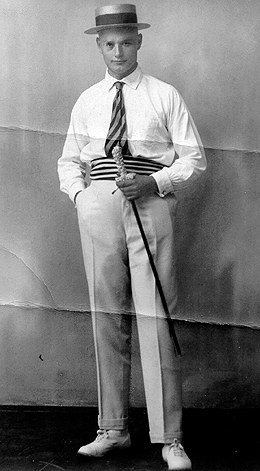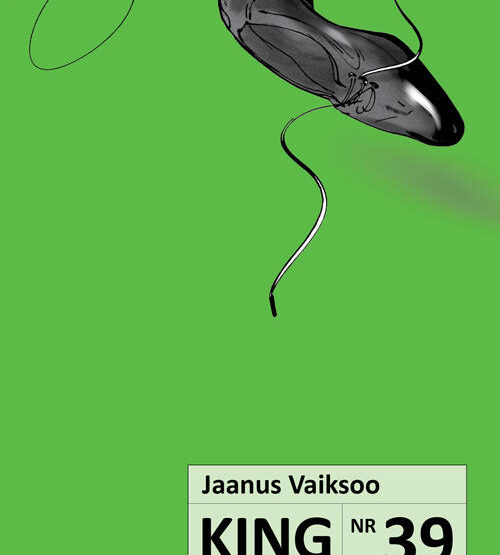1. Beauty and ugliness
The literary work of August Gailit (1891-1960) has fascinated readers of different generations throughout the twentieth century. His style charms the reader, leaving no one untouched, and is immediately recognisable. It displays a burgeoning imagination, dash and verve, tenderness and love, and also enjoyable skill with words.
August Gailit began writing at an early age. At nineteen he published his first work, the short story When the Sun Sets (Kui päike loojub, 1910). From then on, he lived the life of a writer for half a century. Gailit’s last oeuvre was the trilogy Do You Remember, Dearest? (Kas mäletad, mu arm?, 1951 1959).
It has sometimes been ironically remarked that Gailit wrote one and the same novel throughout his life: the same style, similar characters and topics. This is by no means true a writer with a wealthier imagination is hard to find. However, his entire output focuses on the eternal opposition of beauty and ugliness. This constitutes the compositional axis that carries Gailit’s works, from the first pages to the last. On the second page of his first book, Gailit writes in the vein of a good student essay: “Clouds divide the world in two: here is the land and up there the sky. Here oppressive darkness, there eternal light; here pain and tears, there silence and happiness; here screaming for light, there the quiet murmur of the gods; here boredom, there the sun.”
The same Gailit, years later, borrows the poetic title to his swansong, Do You Remember, Dearest? from none other than Baudelaire, who in his famous poem Une Carogne, writes: “Do you remember, dearest, what appalled our senses/ that mild summer morning: an obscene and vile corpse in its flinty bed/ was lying in the curving path.”
For Gailit, beauty and ugliness are just as important as truth and justice are for Tammsaare. This is Gailit’s philosophy of life, concisely summarised in his novel The Flaming Heart (Leegitsev süda, 1945):
“As I have said the contemporary world does not recognise good or bad, black or white; there is only man with a thousand faces, who wants to live and breathe. We regard man together with the whole complex of his passions. We don’t say that this is good and that is bad, this is allowed and that is forbidden, this is beautiful and that is ugly. We know that good is inseparable from evil, and even the greatest beauty carries with it ugliness and the stink of rotting from the day it is born.”
August Gailit belonged to the famous literary group Siuru, together with Friedebert Tuglas, Artur Adson, Marie Under, Johannes Semper and Henrik Visnapuu. The Siuru period was remarkably prolific for Gailit. These years shaped the young inexperienced writer into a well known wordsmith. He published the collection of short stories, The Devil’s Merry Go Round (Saatana karussell, 1917), the novel Fairyland (Muinasmaa, 1918), the short story The Death of August Gailit (August Gailiti surm, 1919), the satire collection Clowns and Fauns (Klounid ja faunid, 1919), the collection of short stories Knights Errant (Rändavad rüütlid, 1919), the novel Purple Death (Purpurne surm, 1924) and Idiot (Idioot, 1924) which consisted of two short stories.
Gailit’s work of that period suffered the impact of the grim era, i.e. the First World War and the years that followed. Or, sticking to the writer’s main axis of beauty versus ugliness; ugliness transformed into the aesthetic clearly prevailed. What, then, did Gailit write about? He wrote about the Devil who lures people to the path of sin and turns a convent into the vilest of brothels; he wrote about a pious nun who after sinning with the Devil, gives birth to five blue piglets. In his novel Purple Death, the mysterious disease destroys only men. The women remain alone and lose their meaning in life. The few surviving men perish amidst frenzied hordes of women who wage bloody battles to get them. The dreadful disease destroys whole nations. The world is doomed.
Such limitless fantasy did not merely arise from Gailit’s desire to irritate the petit bourgeois public and various moralisers. Considering what real life was throwing up, these flights of fancy did not seem particularly outrageous. In the turmoil of World War I, the meaning of life was lost, and people lived for the present alone. Gailit was simply recording surrounding reality, adding his own stylistic colouring to it.
In the writer’s generally gloomy early work, one brighter spot vividly stands out. It was the novel Fairyland (1918), the story about the adventures of two bohemians, the writer Morin and the painter Bruno Erms in summertime Estonia, full of joie de vivre. The romantic story is full of love and passion, alternating with the beauty of summer nature and descriptions of village life, accompanied by Gailitesque humour.
From Fairyland onwards, the reader gets an increasingly vivid picture of Gailit’s perception of nature. Romantic descriptions (sunsets, lakes, meadows) burst to life in Gailit’s text. To express the inexpressible in words is a great skill. The writer does not employ lavish poetic imagery, but nevertheless evokes lively pictures in the reader’s mind.
“With the approach of autumn, the sun grew tired and sank lower each day. The sky was blue and lucid, solitary scraps of cloud roamed like silver scaled roach in a blue lake. The departing storks screeched above the reddish woods. The birch trees yellowed, maples turned red, the wind stripped trees and bushes bare. Woods and paths were covered with colourful leaves like the motley hide of a tiger. Rowanberry clusters flared red, the leaves on the oak trees turned black and withered.”
The above autumnal picture starts off his short story His Royal Highness (Tema Kuninglik Kõrgus) in the collection Crusaders (Ristisõdijad, 1927). The title story of the same collection has another charming description of nature which displays another favourite motif in Gailit’s oeuvre a eulogy to the nature of his homeland and to that of all the Nordic countries. He feels very close to everything connected with these lands: nature, man, the rhythm of life. The most beautiful descriptions of Nordic landscapes are presented in the novel Ekke Moor (1942). The old Sami sage Uutsö here expresses the entire Nordic perception of life. The Northern realm means pure, pristine nature, qualities reflected in the people inhabiting this region their lives are calm, unspoilt by the vices of civilisation.
In his novel Flaming Heart, published in Stockholm in 1945, Gailit opposes the corruption of big cities to the purity and beauty of the countryside. Nature often becomes a metaphor for man. In the changeability of nature, the writer sees the character and tremors of the soul and whims of human beings. It is not by mere chance that Gailit compares early morning sunrise and budding nature to the miracle of human birth.
Describing the nature of his homeland, Gailit simultaneously portrays people who inhabit it: reserved and undemonstrative to the stranger’s eye, jealously concealing their emotions, hard working people whose warm hearts are indeed difficult to notice at first glance. Such oppositions between an Estonian’s rough exterior and inner nature were very much evident in August Gailit himself. His height of nearly two metres, his roaring laugh, his shocking deeds and original literary work kept him constantly in the public eye. For most people, he was a bohemian, a poseur and a cynic who ridiculed society. This, however, was merely one side of Gailit’s dual nature. His outward happy go lucky demeanour, bravura and loud laughter, in fact, concealed a sensitive and tender heart that needed human closeness and the support of his friends.
2. Toomas Nipernaadi
Toomas Nipernaadi is widely regarded as August Gailit’s most personal work of fiction. It is the story of a man who leaves town in early spring, at the time when the ice starts to melt, and sets off to wander around, from one village to the next. Wherever he turns up, adventures and trouble ensue. Nipernaadi works as a rafter and a pastor, drains swampland, becomes the master of a farm. He spins wondrous (fairy) tales to the village maidens who then all fall in love with him.
Toomas Nipernaadi is a phenomenon in Estonian culture. Its heyday was just after its publication. Reviews abounded and critics were unanimously enthusiastic. Despite universal praise, readers interpreted the book in quite different ways. For some, the joyful motto of the book served as a key to understanding the whole thing: A sailor came from Rasina, hey ho, hey ho. Others were taken with the more serious side of the novel. Nipernaadi’s adventures were by no means infinite merrymaking, but rather slipped constantly into tragicomedy. Nipernaadi was one of the first works in Estonian literature that was translated into many languages. To date, the novel has been published in nine: German, Dutch, Czech, Lithuanian, Polish, Finnish, Latvian, French and Russian.
The first was the German translation in 1931 issued by the Ullstein publishing house. The German critics’ reaction was lively and extremely positive (the critics included Hermann Hesse and Hans Fallada). Such success understandably increased the novel’s popularity at home even further and raised great hopes in the author: the Nobel prize and a Hollywood film.
Following Toomas Nipernaadi’s wanderings through spring, summer and autumn, the reader perceives a mythical model of life in the novel: the sequence of seasons, repetition, the closed circle, the cycle of life. And in that circle is Toomas Nipernaadi the eternal wanderer. What gives Nipernaadi the aura of a mythical character is his direct contact with nature. Nature is a significant component of the novel which, through Gailit’s masterful descriptions, acquires the status of a character in its own right. Not by chance was the German edition entitled Nippernaht und die Jahreszeiten, stressing the importance of nature. The whole composition relies on the seasons.
August Gailit’s female characters have been a constant bone of contention. Is the author’s attitude to women cynical ridicule and cruel insult, or pure emotion, passionate love and eulogy? These are the two extremes of readers’ opinions, which is as it should be, because Gailit, after all, was a man of extremes and contrasts himself.
In his work, Gailit often referred to the depravity and brutality lurking behind pure and charming beauty (the captain’s daughter Inriid Rand in the novel Purple Death). On the other hand, he could easily treat a degenerate prostitute from the underworld as an innocent virgin on whom he lavished beautiful words:
““Rea, Rea!” he calls out in a whisper. “I’m calling your name, do you hear me? You will let me have a glass of wine, to your health and mine, won’t you? I feel as if we got engaged today, because I cannot take my eyes off you. What beautiful marble white arms you have. And lips dry as a desert that has been thirsting for water for centuries. Rea, you haven’t been kissed for hundreds of years so thirsty your lips seem to me.”“ (The Death of August Gailit)
Gailit was a romantic, and his attitude towards women was romantic too. He never ceased to worship all those girls and women to whom he gave life in his work. Women also play a significant role in Toomas Nipernaadi. The novel, consisting in fact of seven short stories, focuses on love affairs and amorous adventures. Nipernaadi’s famous passionate monologues might well seem to the reader like masterly adaptations of the Song of Solomon.
Toomas Nipernaadi as an ode to love, symbol of love. At that level, there is no doubt as to Gailit’s attitude to women. The novel’s central idea is that of deeply perceived human love. This book was written by a man who loved life and people for whom love was sacred:
“No other Estonian writer, with the exception of folklorist Oskar Loorits, has ever had such tenderness and respect for Estonian women as did Gailit, whose almost entire body of work is an ode to a woman,” said Mall Jürna. Love for a woman often extends to praise for the home, as home was most dear to him.
3. Exile
In September 1944 Gailit and his family fled to Sweden. They first settled in the Ormesta manor house near Örebro. A reader well versed in Gailit’s oeuvre, cannot but notice the decisive change of tone in the novels published in exile: Flaming Heart (1945), Across the Restless Sea (Üle rahutu vee, 1951), Do you remember, Dearest? I III (1951 1959). Gailit became more serious; the warm humour, wit, irony and healthy laughter, so familiar in his previous work, can be heard with diminishing frequency. A pessimistic philosophy of life prevailed, and became more prominent throughout his literary career, spanning more than half a century.
The occupation of Estonia and exile had a frustrating effect on Gailit. The grim blows of fate befalling both his nearest relations and the whole Estonian population were too heavy to allow the ageing writer to find new energy and a new zest for life. “Everything written abroad is associated with our lost homeland,” said Karl Gailit of his uncle’s work in exile (Aja Pulss 1991, no 1).
Despite the obvious seriousness, the writer’s style remained much the same. It is still playful, grotesque, instantly recognisable. His work is still based on opposition: beautiful ugly, good evil, warm cold, nature civilisation, God Devil. Gailit’s works thus resemble fairy tales. His characters indeed often tell fairy tales, be these Nipernaadi’s fantasies to his summer loves, or memories of the seven exile lumberjack’s amorous affairs in the trilogy Do You Remember, Dearest?
Gailit’s pessimistic attitude to life is strikingly obvious in his novel Over the Restless Sea. The world’s amazing indifference towards the plight of small occupied nations caused much bitterness in Gailit. It was solid proof that one could not rely on others. The writer is haunted by the myth of Diogenes. This is the novel’s other level pessimistic views of the future of mankind. In the conversation and discussions of the novel’s characters, the name of Diogenes keeps popping up. He was the one who walked the streets of Athens in broad daylight, looking for man, and “failing to find him, as he was quite alone amidst the stupid crowd of the wheeling and dealing greedy beasts.” Today’s mechanised society, founded on capital, has made people’s souls bleakly void, with only a human shell remaining, to be hopefully filled with crowns and dollars.
The first part of the trilogy, Do You Remember, Dearest?, displayed a more cheerful undertone. Seven exiles, all working in the Swedish forest industry, sit around in the cottage, waiting for the storm to abate. To while away the time, they sip moonshine and tell one another stories of their past amorous adventures. The memories of their homeland are happy and youthfully enthusiastic. No wonder that instead of an ageing writer, the reader meets the dashing author of the Devil’s Merry Go Round of the Siuru period: “As if the Devil’s exuberant revels and Hell itself brought forth all the organs.” The eleven short stories of the book offer colourful adventurous pictures that no doubt greatly nourished and soothed exiled readers.
In the last part of the trilogy, Gailit returns to pessimistic discussions about contemporary mankind. The writer’s resignation and weariness are most strongly perceived here.
“Today’s world has blinded our eyes and turned our hearts cold. We can only see ourselves and bemoan our own troubles. What else can be expected of us standardised robots? We are, like all the others, in a permanent hurry, in search of new things to possess. Not to lag behind others, not to be any worse, but stretch out all ten greedy fingers to reach and grasp. Heaven forbid a crumb fall in the lap of another human being! Everything for oneself wealth, power, pride! Even more: the whole world, together with everything that breathes, grows and emerges there! ( )
The world is governed by deceit, lies and carnage. Nothing can put a halt to that. Quite the opposite it is on the increase, and maybe tomorrow the lies and carnage will have become the new truth and justice for the new world. We do not yet understand, but sense, that catastrophe is nigh. No, that won’t be nuclear war, but something infinitely more tragic: a pointless existence, the collapse of all ideals, a slow turning into beasts. It is suffocating in its mindlessness, in the futility of life. We have reached a dead end, and will soon have no more air to breathe.”
With the last novel, Gailit put a full stop to his whole oeuvre. His life work was done, a compact whole. Everything seemed to have been said, nothing was left unfinished. It would be too cheerless, however, to end a story about August Gailit on such a sombre note. Most of his work is, after all, full of joy and happiness, and reading his books should be an enjoyable pastime. Hence a few words about a significant and characteristic feature in Gailit’s books, explained by the writer in his last novel names. The names of his characters are an inseparable part of his style. Sikky Mikky, Peetrus Kuppelvaar, Paal Irvik, Katariina Jee, Toomas Nipernaadi… These are no ordinary Estonian names. Gailit often thought up names and indeed the whole plots of his stories and novels, inspired by a momentary impulse. Sound and rhythm were essential. He claimed he got the idea of Toomas Nipernaadi at a theatre performance, from the sound of a man’s footsteps.
In the words of Jaan Udras (Do You Remember, Dearest?, III), the writer recalls a train journey:
“The wheels were clacking, rhythmical and slumberous. I was almost ready to give up on my pondering when suddenly a name sprang into my mind: Annele Longo. Where did it come from, what connection did it have with anything? I repeated the name to myself. Annele Longo! It had a sound to it, it resonated. I waited in the hope that some pictures might emerge as well, some characters maybe, or events.”
From here, a beautiful story unravels, of a young woman who spends days in a solitary country house, since work takes her husband away for long periods of time. Wandering around on her own, she hears inviting sounds from across the lake where a young smith toils away, banging his hammer on the anvil. The man’s name is Paal Irvik. The writer turns to the reader: “Has it ever happened to you that a name starts resounding in your ears? You have never heard it before, but it’s suddenly there, firmly in your mind. Take ‘Paal Irvik’, for example. It refuses to leave me, takes shape, starts doing something, and I simply cannot get rid of it. The man might be a smith, or a farm hand or a poacher. I don’t know. I simply feel that he is a big, strong man who has had a painful experience in his life which has made him rude and insensitive, a man with a cold heart.”
August Gailit had a warm heart.
© ELM no 14, spring 2002





